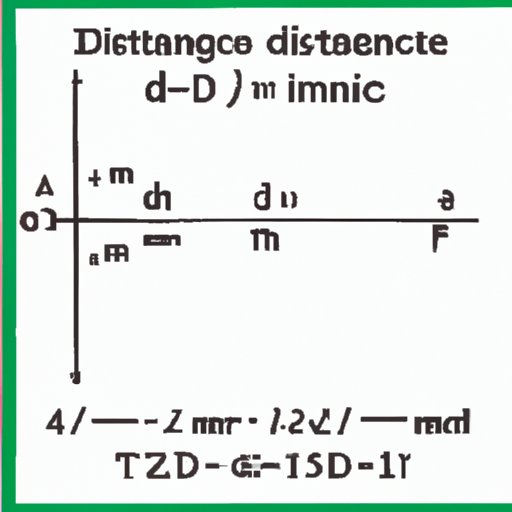
Introduction
Distance, in its simplest definition, refers to the space between two points. It’s a fundamental concept that we regularly encounter and use, whether we realize it or not. Understanding how to find distance is necessary in many aspects of our daily lives, including planning a route for a road trip or measuring the distance between objects. This article aims to provide a comprehensive guide to finding distance and its various applications.
Step-by-step guide
There are several ways to find distance, but the two most popular methods are the Pythagorean theorem and the distance formula. The Pythagorean theorem can be used to calculate the distance between two points in a two-dimensional coordinate plane, while the distance formula can be applied to calculate the distance between two points in a three-dimensional plane.
The Pythagorean theorem states that the square of the hypotenuse (the longest side) of a right-angled triangle is equal to the sum of the squares of the other two sides. To find the distance between two points using the Pythagorean theorem, draw a right-angled triangle between the two points, where the line connecting the two points is the hypotenuse. Then, calculate the length of the other two sides and use the theorem to find the length of the hypotenuse, which is the distance between the two points.
The distance formula is a more generalized method of calculating distances. It states that the distance between two points (x1, y1, z1) and (x2, y2, z2) is given by the formula distance = [(x2 – x1)² + (y2 – y1)² + (z2 – z1)²]½. To use this formula, simply plug in the coordinates of the two points and calculate the value of the distance.
For example, if we have the coordinates (1,2,3) and (4,5,6), we can use the distance formula to calculate the distance between these points as follows:
Distance = [(4-1)² + (5-2)² + (6-3)²]½ = [(3)² + (3)² + (3)²]½ = (27)½ = 3√3
Real-life examples
There are many practical applications of finding distance in everyday life. For instance, when planning a road trip, knowing the distance between cities can help determine the travel time and fuel costs. Similarly, when designing a room, knowing the dimensions of the room can help calculate the amount of material needed to fill the space. Additionally, finding distance on a map is useful for navigation and exploration.
Furthermore, distance is critical in many fields such as aviation, astronomy, and construction, where errors in distance calculations can have severe consequences.
Apps and tools
Several apps, websites, and tools are available online that can make finding distance easier and more convenient. For example, Google Maps is a popular app that can calculate the distance between two points and provide directions for many modes of transportation. Similarly, GPS navigation systems use distance calculations to provide accurate directions.
There are also specialized websites and tools such as DistanceCalc.com and CalculateDistance.org that allow users to calculate the distance between two points on a map or in a coordinate plane. However, it’s important to note that these tools rely on accurate input data and may not be foolproof.
Comparison of measurement units
Measurement units play a significant role in finding distance and can differ across regions and disciplines. The most commonly used units of distance measurement are the metric system and the imperial system.
The metric system, also known as the International System of Units (SI), is used worldwide and is based on the meter as the standard unit of length. Its advantages include its simplicity and ease of conversion between units. In contrast, the imperial system is mainly used in the United States and the United Kingdom and is based on feet and inches as standard units of length. Its advantages include its familiarity among the citizens of these countries.
Converting between units is necessary when dealing with international systems or when changing between different types of measurements. Conversion is easy using conversion tables or online converters, which provide accurate results in seconds.
Common mistakes
Mistakes are bound to happen when calculating distances, especially when using complicated formulas or relying on input data. A common error is inputting the wrong formula or transposing coordinates, which can lead to incorrect results.
To avoid these mistakes, double-checking the input data and the formula being used is crucial. Also, it’s essential to understand the concepts and methods well before attempting any calculations.
Advanced techniques
Advanced techniques used to calculate distances incorporate vector algebra and calculus. These techniques are mainly used in science, engineering, and research where precision is crucial.
Vector algebra involves using vectors to represent distances between two points. Vectors have magnitude and direction and can be added and subtracted to obtain the distance between two points.
Calculus involves the use of derivatives and integrals to solve complex problems, such as finding the shortest distance between two points on a curved surface. These techniques are more challenging to grasp, but they offer more accurate and precise results.
Conclusion
Understanding how to find distance is essential in many areas of our daily lives. It’s an easy concept to grasp, and there are many tools and techniques available to make it easier. Whether you are planning a road trip, designing a room, or exploring outer space, knowing how to calculate distance is an invaluable skill.





